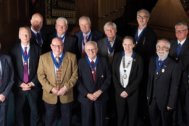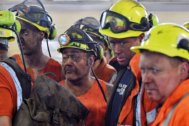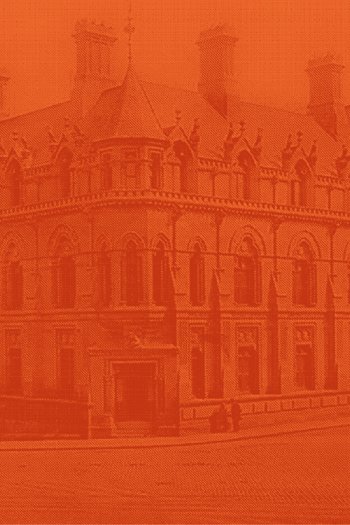You’ll learn:
- About the Institute’s founding ambitions to revolutionise the mining industry, save lives and drive-up standards
- About the building’s important role as the world’s very first innovation hub where the industrial technologies of deep mining, the railways and coal fired power station were developed
- How the vision for the North of England Institute of Mining and Mechanical Engineers has translated to The Common Room today
In 1852, after a sequence of disasters at pits across the Great Northern Coalfield, a group of young mining engineers founded the North of England Institute of Mining and Mechanical Engineers with Nicholas Wood, their leader, as its first President.
The principal object of the Institute was:
By a union of concentration of professional experience to endeavour if possible, to devise measures which may avert or alleviate those dreadful calamities, which have so frequently produced such destruction to life and property, and which are always attended with such misery and distress to the mining population of the district.
On Wood’s death in 1865, the Institute resolved to create a base for its activities in a Wood Memorial Hall where papers on all aspects of mining and related engineering subjects would be presented and then published in the Transactions of the Institute and circulated globally.
The Wood Hall was placed at the heart of a new building on land immediately next to Central Station. The building, known from the beginning as the Mining Institute, opened in 1872. It was astonishingly radical at the time – a Victorian Gothic addition to the heart of ‘classical’ Newcastle – and a wholly secular and a profoundly ‘regional’ building.
“Minds, books, lectures and education became central. Armed with knowledge and know-how and inspired by the desire to get rich, entrepreneurs emerged within an industrial culture wedded to scientific knowledge and technology. Innovative engineers sought to make sense and profit out of the world around them.”
Professor Margaret Jacob, The First Knowledge Economy
The building also offered a home to what can be seen as the world’s first consciously created ‘innovation hub’. It included offices for the Physical Sciences Department of Durham University, the Coal Trades Associations of both Northumberland and Durham and the Blyth and Tyne Railway, with the Wood Hall, the home of the engineers, at its centre.
“It is not until we reach Silicon Valley that there is another such concentration of globally important (and massively prof- itable) innovation in one ‘tight’ physical location during one short time period.”
John Tomaney, Professor of Urban and Regional Planning, UCL
In 1913, production from the coalfield reached 56.4 million tons with a workforce of 230,000 men. By that time the Institute itself had 2,300 members with 45% of them working abroad. Although unknown at the time, 1913, this marked peak production for the coalfield. The seeds of the Institute’s influence were, however, already spread around the globe through the industrial technologies of deep mining, the railways and the coal fired power station, all developed here. As American author Barbara Freese wrote, it was the engineers of the Tyne and Wear ‘who released the genie of coal into the world.’
The 20th Century
During the 20th century, Institute membership steadily declined as the pits closed. By the end of the century, the Council of the Institute recognised that the ‘seam’ of its membership was running out and its funds were being drained by the costs of its ageing building.
A variety of strategies to achieve sustainability were pursued beginning with the sale of part of the building, then an attempted development partnership with the Literary and Philosophical Society next door and, finally, the repurchase of the whole building and a search for commercial tenants. Despite the best endeavours of a committed voluntary Council and a tiny staff, all failed.
At the end of 2014 – recognising the approach of a financial cliff edge and the imperative of protecting the internationally important collection – the building was placed on the market. A single offer was received from a leisure operator with the Institute to be granted only a 25-year lease on the top floor.
A Last Chance to Find a Sustainable Future
At the beginning of 2015, the NEIMME Council accepted an offer from a supporter to explore an alternative way forward. This was based on recog- nition by The National Lottery Heritage Fund of the serious ‘risk to national heritage’ of losing the Grade II* listed building, the Royal Chartered Institute itself and the collection.
The Heritage Fund indicated that immediate transitional funding might be available to buy the time to prepare a development strategy and plan. As a foundation for such a plan, an ‘in principle’ commitment to implement the strategy from NEIMME would be required.
In September 2015, NEIMME Council unanimously adopted the following resolution.
The Vision
The North of England Institute of Mining and Mechanical Engineers founded to address the safe and effective exploitation of the natural resources of the North East – will create as a legacy a new Institute dedicated to exploring the future of that Region, its people and the distinctive contribution it could make to the global as well as regional consequences of the Industrial Revolution that began – and ended – here.
The Challenge
If a future for the building could be found that:
Delivered a range of public benefits to the North East in line with the vision;
Indicated – believably – that capital funds could be raised to restore and adapt the fabric of the building and conserve the collection;
Demonstrated that a sustainable business model could be found to operate the building and deliver the public benefits;
Guaranteed support for NEIMME’s own programme in perpetuity……
Then….
NEIMME was prepared – in principle – to transfer its assets of property, collection and staff to a new charitable entity charged with stewardship of those assets and the delivery of a programme of public benefits.
This resolution provided a ‘key stone’ for the successful Heritage Fund application for transition funding to sit with a ‘bridging’ grant of £50,000 from The Reece Foundation and a mortgage repayment holiday from Newcastle City Council.
Addressing the Triple Challenge of the Vision
Time had been bought and a triple challenge had been accepted. How could more definition be given to both the heritage and future oriented dimensions of the vision? Could both then be connected synergistically in the concept and mission of a new organisation?
The Heritage
On the 19th December 2015, a hundred NEIMME members gathered in the Lecture Theatre on the 150th anniversary of the death of their first Presi- dent. (See Fig. 1)
Dr Bill Lancaster delivered a lecture on Nicholas Wood and his fellow first Directors of the Institute. On that same day, poignantly but serendipitously, the last shift in the last deep pit in the UK came to the surface at Kellingley (See Fig. 2). After the lecture, the members present observed a minute’s silence ‘for a great industry’.
300 years after the arrival of steam power on the Great Northern Coalfield, 200 years after the plans for the first deep mine and 100 years after ‘Peak Coal’, it was over. This 300-year heritage which already formed the core of the collection would now be the principal focus for delivering the first part of the vision.
The Future
During 2015 the Development Director had conducted over 100 tours of the building with the region’s leadership across all sectors – politics, economics, education, spiritual, industrial, trade unions, civil society, culture, media – and from the Tweed to the Tees.
Visitors had recognised:
The accessibility of the location at the region’s railhead to national as well as regional users.
The history of the Institute as one of service to the communities of the whole coalfield.
The potential of the beautiful, historic and functional spaces it contained when refurbished.
The surprise factor with so few of the region’s population ever having been inside it.
The importance of keeping the collection intact and housed in context in its original home.
There was, therefore, a sense in which the reborn building could act as a focal point for discussion by all of the interested sectors around the future of the region – an aspiration already embedded in NEIMME Council’s ena- bling resolution and a principal focus for the second part of the vision. How though, could such a complex and diverse set of subjects and issues – albeit rooted geographically and in terms of heritage – be captured in a single empowering concept?
The Director of The Saltire Society in Edinburgh, Jim Tough, was a long- standing critical friend of the project. Rather than seeing the complexity and diversity of such a diverse programme as a problem, he embraced it. He suggested – referencing the Scottish Enlightenment in the late 18th and early 19th century – that such an array of subjects, meeting ‘on neutral ground’ and of ‘the expert, the informed, the interested and the curious’ be thought of as taking place in a ‘common room’.
This became the organising concept for the major application that was submitted to The National Lottery Heritage Fund in the middle of 2016, jointly, by The Common Room and NEIMME.
In a Special General Meeting in October 2016, the membership of NEIMME, resolved to transfer their assets subject to an award being made by the Heritage Fund. On 15th November 2016, the Heritage Fund made the funding allocation and the work of The Common Room could begin.
Bio
In 1984 Peter Stark returned to the North East as Director of Northern Arts after 20 years learning his trade as a project developer and manager, teacher and policy analyst in the arts and culture around the UK. In the mid-1990s he served as Special Projects Adviser to Gateshead Council on the Baltic Gallery, the Millennium Bridge and what became Sage Gateshead and then moved to Northumbria University as Professor and Director of the Centre for Cultural Policy and Management in 2000.
In that capacity he developed a sister Centre in Johannesburg and, on relocation to South Africa, his own consultancy and a formal cultural exchange partnership between the North East and the Eastern Cape, ‘The Swallows Partnership’. Returning to the North East in 2012, he founded GPS Culture and published a suite of influential reports on Arts and Lottery policy and funding imbalances between London and the rest of England, triggering a Parliamentary Select Committee.
In 2015 Peter joined the North of England Institute of Mining and Mechanical Engineers (NEIMME) as Development Director raising funds to secure the building and collection. He then became Project Lead for Civil Society in the region helping to create a coalition to address the Climate Crisis. He was awarded the OBE for his work at Northern Arts in 1992 and an Honorary Fellowship of NEIMME in 2017.




